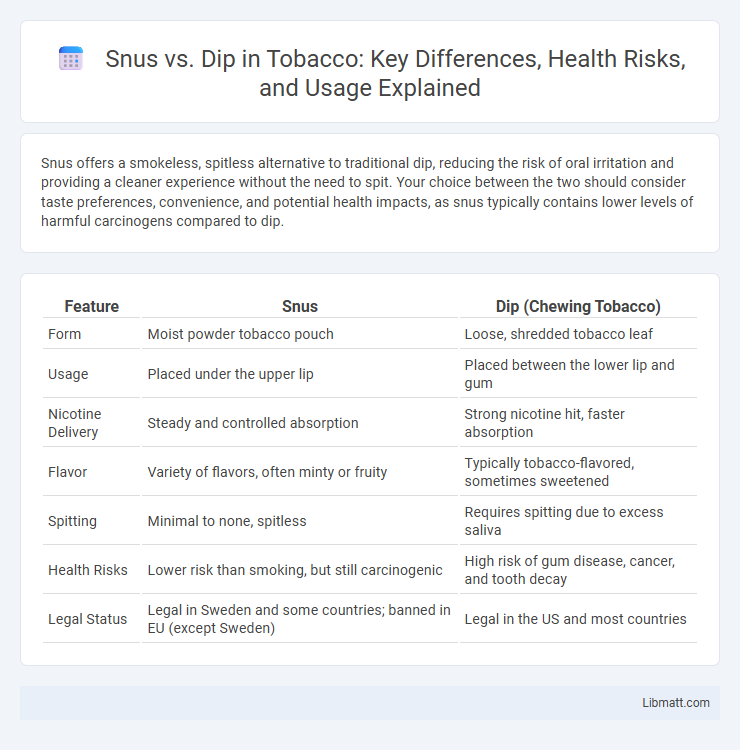Snus offers a smokeless, spitless alternative to traditional dip, reducing the risk of oral irritation and providing a cleaner experience without the need to spit. Your choice between the two should consider taste preferences, convenience, and potential health impacts, as snus typically contains lower levels of harmful carcinogens compared to dip.
Table of Comparison
| Feature | Snus | Dip (Chewing Tobacco) |
|---|---|---|
| Form | Moist powder tobacco pouch | Loose, shredded tobacco leaf |
| Usage | Placed under the upper lip | Placed between the lower lip and gum |
| Nicotine Delivery | Steady and controlled absorption | Strong nicotine hit, faster absorption |
| Flavor | Variety of flavors, often minty or fruity | Typically tobacco-flavored, sometimes sweetened |
| Spitting | Minimal to none, spitless | Requires spitting due to excess saliva |
| Health Risks | Lower risk than smoking, but still carcinogenic | High risk of gum disease, cancer, and tooth decay |
| Legal Status | Legal in Sweden and some countries; banned in EU (except Sweden) | Legal in the US and most countries |
Introduction to Snus and Dip
Snus is a moist powder tobacco product placed under the upper lip, originating from Sweden and known for its smokeless, discreet use. Dip, or dipping tobacco, is a form of smokeless tobacco composed of coarsely ground tobacco leaves placed between the lower lip and gum, popular in the United States. Understanding the differences in nicotine delivery, usage style, and cultural background helps you make an informed choice between Snus and Dip.
Origins and History of Snus and Dip
Snus originated in Sweden in the early 18th century as a moist powder tobacco placed under the upper lip, evolving from traditional chewing tobacco. Dip, or dipping tobacco, traces back to the United States in the late 19th century, developed as a coarse-ground, smokeless tobacco product commonly used between the lower lip and gum. Both products reflect cultural tobacco use trends but differ fundamentally in preparation, usage, and regulatory frameworks.
Key Ingredients and Composition
Snus is a moist powder tobacco product typically made from ground tobacco, salt, water, and flavoring agents, including pH-adjusting substances like sodium carbonate to control nicotine absorption. Dip, or dipping tobacco, consists of coarsely ground tobacco leaves mixed with flavorings and often contains added sweeteners and preservatives, but usually lacks the alkaline agents found in snus. The differences in composition influence the nicotine delivery and user experience, with snus generally offering a steadier nicotine release compared to the more variable absorption in dip.
Methods of Use: Snus vs Dip
Snus is a moist powder tobacco placed under the upper lip for extended periods, allowing nicotine absorption without spitting, while dip involves placing shredded tobacco between the cheek and gum, requiring frequent spitting due to saliva accumulation. Snus is typically packaged in small, pre-portioned pouches offering consistent flavor and reduced mess, whereas dip is loose, demanding users to pinch and pack the tobacco manually. The discreet placement of snus under the lip minimizes oral irritation compared to dip, which often causes gum discomfort and increased saliva production.
Flavor Profiles and Varieties
Snus typically offers a range of mild, moist flavors such as mint, bergamot, and subtle tobacco, delivering a smoother and less abrasive taste compared to dip. Dip, or chewing tobacco, features bolder, more robust flavor profiles often infused with sweet, smoky, or spiced notes, and is usually drier and grainier in texture. Both products provide diverse varieties catering to different preferences, but snus emphasizes a refined, less intense sensory experience while dip focuses on strong, long-lasting flavors.
Health Risks and Side Effects
Snus presents lower health risks compared to traditional dip due to its pasteurized processing, which reduces harmful nitrosamines linked to cancer. Dip carries higher risks of oral cancers, gum disease, and tooth decay because it contains unpasteurized tobacco with greater toxic compounds. Both products cause nicotine addiction, but dip often leads to more severe gum recession and mouth sores.
Legal Status and Availability
Snus is legal and widely available in Sweden and Norway, where it is regulated as a tobacco product with clear labeling requirements. In the United States, dip (also known as moist snuff) is legal and sold in most states, but snus faces restrictions or limited availability due to FDA regulations and varying state laws. Your choice between snus and dip may depend on local legal status and accessibility in your region.
Social and Cultural Perception
Snus is often perceived as more socially acceptable and culturally ingrained in Scandinavian countries, where it is viewed as a cleaner, less disruptive tobacco alternative compared to dip. Dip, popular in parts of the United States, carries associations with rural or working-class subcultures and is often stigmatized due to its stronger odor and visible spit. Your choice between snus and dip can influence social interactions based on these cultural perceptions and local attitudes toward tobacco use.
Popular Brands and Market Trends
Popular brands in the snus market include Swedish Match's General and Skruf, while dip is dominated by U.S. brands like Copenhagen and Skoal. Market trends show increasing demand for snus in Europe due to perceptions of lower health risks, with a growing interest among younger consumers seeking discreet tobacco alternatives. Your choice between snus and dip may depend on brand availability and regional popularity influenced by regulatory environments and consumer preferences.
Choosing Between Snus and Dip
Choosing between snus and dip depends on personal preferences regarding health risks, usage convenience, and flavor options. Snus offers a smokeless, low-smoke alternative that is placed under the upper lip, resulting in less spit and lower exposure to carcinogens compared to dip, which is placed between the lower lip and gum and produces more saliva and smoke-like exposure. Users seeking a discreet, less harmful tobacco experience often prefer snus, while those valuing traditional tobacco flavors and stronger nicotine delivery may lean towards dip.
Snus vs Dip Infographic

 libmatt.com
libmatt.com